This is an Adox 300, a 35mm viewfinder camera produced by Dr. C. Schleussner Fotowerke GmbH in Frankfurt, West Germany starting in 1956. The Adox 300 is a pretty unique camera in that it supported interchangeable magazine film backs, a feature not commonly found on 35mm cameras. In the Adox 300, the entire film compartment was in a self contained magazine which was equipped with a dark slide which allowed the photographer to swap rolls of film and out out of the camera mid roll. The feature functioned similarly to medium format cameras like the Bronica or Hasselblad SLRs, giving the Adox 300 appeal to photographers who had a need to change between different film stocks without having to keep rewinding the film. Aside from the magazine back, the camera was a well built, but simple fixed lens viewfinder camera with a good Schneider-Kreuznach triplet.
Film Type: 135 (35mm)
Lens: 45mm f/2.8 Schneider-Kreuznach Xenar coated 3-elements in 4-groups
Focus: 3.5 feet to Infinity
Viewfinder: Scale Focus
Shutter: Compur Rapid Leaf
Speeds: B, 1 – 1/500 seconds
Exposure Meter: Uncoupled “Automatic” Bewi Selenium Cell w/ top plate EV readout
Battery: None
Flash Mount: Cold shoe X Flash Sync
Other Features: Interchangeable Magazine Film Back, Self-Timer
Weight: 840 grams
Manual: https://mikeeckman.com/media/Adox300Manual.pdf
How these ratings work |
The Adox 300 is an unusually good camera from a company not known as a maker of too many good cameras. It has a typically high German build quality, a good selection of lenses and shutters, and has perhaps the best implementation of an interchangeable magazine film back of any camera that supported that feature. The Adox 300 isn’t a super common camera, and although lacks a rangefinder, is a lot of fun to shoot and makes great images. It is definitely worth adding to your collection. | ||||||
| Images | Handling | Features | Viewfinder | Feel & Beauty | History | Age | |
| 2 | 1 | 2 | 1 | 2 | 1 | 30% | |
| Bonus | none | ||||||
| Final Score | 11.7 | ||||||
History
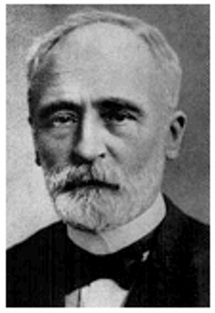
In 1860, Heidelberg University student Carl Schleussner (1830-1899) set up a laboratory in Frankfurt that initially specialized in pharmaceuticals. However, the focus changed when Dr. Schleussner was introduced to Dr. Richard Leach Maddox’s dry plate invention in 1871. He experimented with the plates, and was so impressed with his improvements that his laboratory was soon transformed into a factory that manufactured and sold high-quality gelatin emulsion dry plates worldwide. Dr. Schleussner then began a successful collaboration with physicist Conrad Wilhelm Rontgen, which resulted in the development of X-ray plates. Soon, Dr. Schleussner’s fledgling company became the foremost international manufacturer of X-ray plates.
However, Adox, as the factory became known, continued being a major force in photographic innovation long after the death of its founder, most notably in the field of color photography. Dr. R. Fischer’s experiments in chromogenic processes were applied to the company’s unique color coupling method in 1911. But a major problem soon arose when the dyes resisted mixing. Numerous tests later, Adox technicians finally discovered suitable dyes and patented its new pioneering technology. Another prosperous industry was born. By the 1920s, Adox commenced its camera manufacturing operations in Wiesbaden. After Adolf Hitler seized power in Germany and began his infamous persecution of Jews, the fallout resonated within the photographic industry. Siblings Heinrich (“Henry”), Max and Josef Wirgin were forced out of Germany to escape the Nazi purge. The Wiesbaden-based Wirgin camera factory was incorporated into the ever-growing Adox conglomerate in 1938.
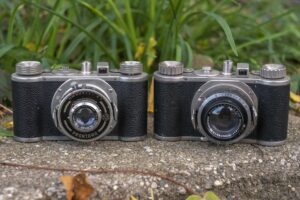
During the era of Adox’s ownership of Wirgin, a number of Wirgin era cameras like the Edinex and Gewirette were sold, rebadged as the Adox Adrette and Adrette 3×4. These cameras were simple rebadges and identical in everyway to their Wirgin counterparts. After the war, Adox discontinued these models and control of the factory was sold back to Henry Wirgin.
After World War II, Adox would resume much of it’s prewar film and camera making business. Instead of rebadging other cameras, simple models like the Adox Sport and Start were sold. Eventually, the company would get back into 35mm cameras with an ambitious model called the Adox 300. The 300 would be an all new camera with a couple features found on very few other cameras, such as a left thumb rapid film advance and interchangeable film magazines allowing the user to swap rolls of film mid roll without having to rewind the film. Although a common feature on medium format cameras, only a few 35mm cameras such as the Kodak Ektra had attempted such a feat before.
There exist a couple variants of the Adox 300, which have different combinations of lenses and shutters. A model referred to in some literature as the Adox 300 C has a 3-element 45mm f/2.8 Steinheil Cassar and another called the Adox 300 X has a 4-element 45mm f/2.8 Schneider-Kreuznach Xenar. Versions with a Compur-Rapid and Synchro-Rapid have been found with both lenses. Versions with the focus scale in feet and meters also exist. From what I can tell, every variant of the camera was simply called the Adox 300, and any sub model names were applied by collectors and should not be considered official names.

Finally, a cosmetic change from earlier and later Adoxes exist in which the earlier models have the name “Dr Schleussner” engraved in cursive above the shutter plate and “Dr. C. Schleussner Fotowerke GmbH, Made in Germany” on the top plate. Later versions omit the cursive name above the shutter and change the name on the top plate to “ADOX Fotowerke Dr. C. Schleussner GmbH”, and “Made in Germany” is located to the bottom of the film door.
Based on my un-scientific research of Googling images of the Adox 300, it appears the versions without the cursive are much more common. It is even possible that the cursive logo ones were pre-production only as the only examples I can find are in advertisements.
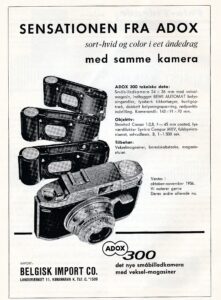
The Adox 300 was never exported to the United States, at least not in any significant numbers, but it did appear in ads all over Europe. German, Dutch, and English language ads have been found including the Danish ad to the right which clearly shows the Cassar lens version for sale. No mention of the Schneider Xenar is shown, either suggesting that this lens was only available in specific markets, or that perhaps it was only available at a later time.
In another ad, the camera was advertised in Denmark for 650 Kr, which I will not attempt to convert to USD, but my best guess is it would translate to “not too high, but also not cheap either”.
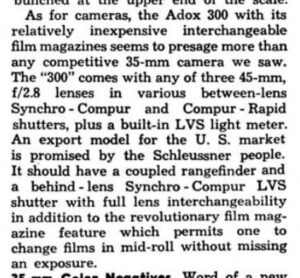
The only references to the Adox 300 I was able to find in American publications were short previews in which the camera is acknowledged, but that a more advanced model was on the horizon.
Adox 500
If while looking at the Adox 300, you thought to yourself, “boy that camera looks like it should have a rangefinder”, you’re not off the mark as a rangefinder version called the Adox 500 was planned as a follow up or complementary model to the Adox 300.
In their coverage of Photokina 1956, the February 1957 issue of Popular Photography has a paragraph stating that a version with a coupled rangefinder and interchangeable lenses was going to be exported to the United States. The development of the camera made it to the prototype stage and at least one was produced showing off what would have become the Adox 500.
Exactly how many prototypes were produced or why the camera never saw a wide release is unclear, but at least one prototype with three different lenses was created and in the gallery below, the camera looks 100% complete and ready for release, so whatever decision was made to scrap the model, likely happened in the 11th hour.
All images in the gallery below are courtesy, liveauctioneers.com.
From the photos in the gallery above, it is clear that Schleussner Fotowerke delivered on their promise of a model with a coupled rangefinder and interchangeable lenses, but there appear to be quite a few more changes than that. Looking at the images above, I can see the following changes from the regular Adox 300.
- The viewfinder window looks to be much larger, with a larger rectangular opening on the back of the camera, instead of the smaller round one on the Adox 300. Also, what looks to be a frosted window on the front of the camera between the viewfinder and rangefinder window suggests the viewfinder has projected frame lines visible for the standard 50mm lens, and possibly for optional 35mm and 85mm accessory lenses.
- The accessory shoe was moved to where the Bewi meter and readout was.
- The meter was moved to the other side of the camera and instead of the push button automatic meter feature, the Adox 500 appears to have a more traditional match needle design. This possibly suggests the meter was coupled to the shutter, unlike the Adox 300 which was uncoupled.
- To the right of the accessory shoe is a chrome button, whose function is unknown. Perhaps this enabled the match needle meter, changed the frame lines visible in the viewfinder, or something else entirely.
- To make room for the new match needle meter read out, the top plate shutter release was relocated to the front body of the camera, next to the lens mount.
- The flash sync port was relocated from the side of the shutter, to the camera’s left side, above the door latch.
- The original Compur-Rapid shutter was replaced with a Synchro-Compur shutter with what looks to be an interchangeable DKL bayonet lens mount, similar to the one used by Kodak AG, Voigtländer, Braun, and a few other German companies.
- The standard kit lens would have been a slightly longer 50mm f/2.8 Schneider-Kreuznack Adox-Xenar lens, with optional 35mm f/2.8 Adox-Curtagon wide angle and 85mm f/4 Adox-Tele-Arton telephoto lenses available.
It appears as though the new model retained support for the exact same magazine backs and method for changing film, and also the front thumb film advance lever next to the shutter. In fact, there appear to be more changes than what stayed the same as the list of changes for the upgraded Adox 500 would have made it a pretty compelling, and likely quite a bit more expensive camera.
There is very little info out there regarding the fate of the Adox 500, but I’ve researched enough cameras on this site that I can make an educated guess that probably by the time the camera was nearly complete, the market for premium leaf shutter interchangeable lens rangefinder cameras was drawing to a close. By 1957 or 58 when this camera would have been ready for sale, the dawn of the 35mm SLR was already upon us, and manufacturers all over Germany and Japan were scaling down their rangefinder production, and prioritizing SLRs. Further more, lack of brand recognition in the United States, plus poor distribution likely doomed it, and the camera was scrapped.
With plans for the upgraded Adox 500 scrapped and the Adox 300 selling slowly, around 1958, Schleussner Fotowerke made the decision to exit the camera making business and instead focus on Adox film and other industries that the company was involved in.

In a strange twist, around the time the Adox 300 was discontinued, the patents and tooling for the Adox interchangeable magazines was sold to Ernst Leitz Wetzlar for use in a microscope camera called the Leitz Orthomat. Manufacture of the magazines continued under Leitz ownership and would be engraved with the name “Leitz Wetzlar Germany”. The Leitz made magazines were made in black, white, olive, and possibly a couple other colors, to match the industrial microscope cameras that they were used in.
Today, there are dedicated collectors of a great many brands and styles of camera. There will always be a place for German cameras, but those who specifically collect Adox cameras or those with interchangeable magazine backs are few and far between.
For those with more general tastes (like me), the Adox 300 represents a curious entry into the world of camera history. A model that was both simple, yet advanced at the same time. The Adox 300 is a well built camera with a good lens and shutter, making it capable of excellent images, but also the ability to hot swap between rolls of film midroll is a compelling option. This is a neat camera that is definitely worthy of consideration in your collection.
My Thoughts
Interchangeable magazine back medium format cameras are pretty common. Most Hasselblad and Hasselblad style cameras have the ability to hot swap rolls of film mid roll, allowing you to alternate between color and black and white film, slide and negative film, or even different speeds of film without having to completely finish a roll.
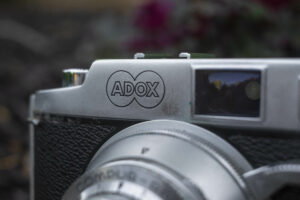
Strangely, for as common as this feature was in the medium format world, for 35mm film cameras, the feature was very rare. Only a few cameras ever had the ability to swap film mid roll, the Kodak Ektra, which itself was a super rare camera, the Mamiya Magazine, and the Zeiss-Ikon Contarex also had this ability, but for pretty much every other camera, if you wanted to swap your film mid roll, you had to get creative by remembering what exposure number you were on, rewinding the roll back into the cassette (without losing the leader into the cassette) and then loading in another roll and blank firing it to where you left off on that roll, and so on.
In the rare company of 35mm cameras with interchangeable magazine backs, there’s one more model, the Adox 300, an interesting, and like the others, short lived model that allows you to hot swap film compartments mid roll. I was aware of the Adox 300 for quite some time, but realizing I wasn’t likely to find one at an affordable price, I put it on my list of cameras that if I ever found cheap enough I would pick up, but wouldn’t go out of my way to look for.
When I finally acquired this Adox 300, the first time I took it out of the box, I was amazed as how large and heavy it was. In photos, the Adox 300 doesn’t look all that large. It has that left thumb film advance lever like the Konica III, but other than that, seems rather unremarkable. On the scale however, the camera weighs 840 grams which is in the realm of most interchangeable lens SLRs, not a scale focus fixed lens camera.

In addition to a larger you’d expect body, the control layout of the camera is different than most scale focus cameras. On the left side of the top plate is the readout for the built in uncoupled Bewi automatic exposure meter.
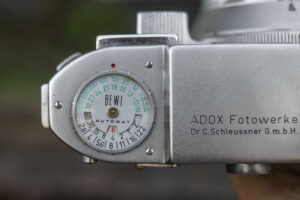
Now, before I go on, I really need to clarify that the Adox 300 does not support automatic exposure. All exposure settings are completely manual. The meter itself isn’t even coupled to anything, so changing shutter speeds and aperture f/stops won’t have any effect on the meter. So what exactly is an “automatic exposure meter”?
Reading the Adox 300 user manual, the steps for using the meter are to first rotate the outer ring so that the desired DIN or ASA film speed lines up with a red dot on the top of the camera. With the correct film speed set, put the camera to your eye and compose your image. Once you’ve done that, press and hold a chrome button on the back plate of the camera below the meter for 2 seconds and then release the button. After releasing the button, remove your eye from the viewfinder and look at the red number in the read out and this is the detected EV value, from 2 to 17. To set the exposure, rotate the shutter speed and aperture rings on the shutter so that a matching EV number on the side of the shutter matches up to a red index mark. As I type this, I realize this sounds really complicated to read, so I made a short video showing how it works.
Back to the top plate, an engraving with “ADOX Fotowerke Dr. C. Schleussner G.m.b.H.” comes next as does an accessory shoe. On the far right is a large oval shutter release which is threaded for a cable release, and then a large triangular window with the exposure counter beneath. The exposure counter seen through this window is actually part of the film magazine in the camera. This allows you to easily tell if a magazine is in the camera as if this window is blank, it is empty. The exposure counter is subtractive, showing how many exposures are left on a roll of film and must be manually reset after loading in a new roll of film. The exposure counter only works with film in the camera, so activating the film advance and shutter release with no film in the camera will not make the exposure counter change.
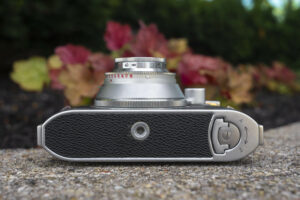
The base of the camera has a large patch of pebbled body covering over most of the bottom surface. In the middle is a 1/4″ tripod socket which is centrally located, helping to balance the heavy body while mounted to a tripod. On the right is a folding key which serves multiple purposes, the most basic of which is it unlocks the rear door so that you can access the film magazine. A less obvious, but critically important feature of this key is that as you rotate it 180 degrees from the ‘Z’ to ‘A’ position, is a metal dark slide in the film gate closes, blocking light from entering the film magazine. This protects the film inside of the magazine from being exposed when it is removed from the camera.
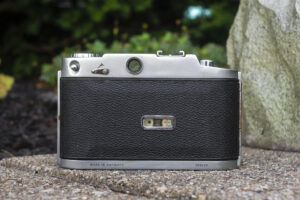
The back of the camera has the round eyepiece for looking through the viewfinder. To the left of the eyepiece is a chrome lever whose purpose is to disengage the film transport in the event the camera is partially wound while reaching the end of a roll of film. A sequence of rotating keys and interlocks exist inside of the camera, which engages the film transport with the film inside of the magazine. These interlocks must always stay in sync, or risk the camera becoming jammed. While designing the camera, engineers found that if the end of a roll of film is reached mid stroke, the camera will jam. To prevent this from happening, this lever was added which temporarily disengages the film transport coupling, allowing you to finish the film advance sequence without actually advancing the film. Although this is not the intended purpose of this lever, it can also be used to allow for intentional double exposures if you so wish.
Next to the chrome button is a round button for taking a reading on the Bewi meter which I discussed above. In the middle of the film door is a rectangular glass window which allows to read two film reminder dials on the back of the magazine. The left dial shows 6 different icons for different types of film, and the right dial shows film speeds from ASA 5 to 400 and DIN 8 to 27. These dials are used as reminders only and have no effect on the meter. Like the exposure counter visible from the top of the camera, these dials are part of the film magazine, so if they are not visible, then it means there is no magazine in the camera.
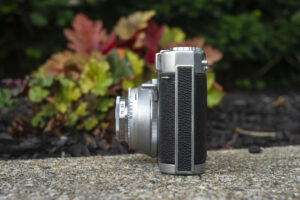
The sides of the camera are symmetrical showing only minor differences. The Adox 300 has forward facing metal strap loops which is useful considering the camera’s left. Two body covered rectangles on both sides of the camera resemble film compartment releases on other cameras, but actually don’t serve any purpose here.
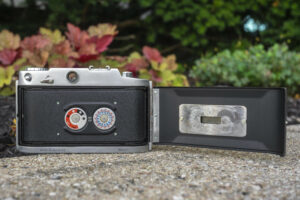
Opening the film compartment using the rotating key on the bottom of the camera is only the first of several steps which will likely be unfamiliar to anyone who has never handled an Adox 300 before. With the film compartment unlocked, the right hinged door opens to reveal….another film compartment!
The signature feature of the Adox 300 is it’s interchangeable magazine film compartment. Loading and unloading film into the magazine requires quite a bit of explanation, so rather than try to type it out, I made a short video where I fumble through the process. It’s definitely not my best video, but it was difficult to do while recording the process, but I think is good enough to explain it to the first time user.
Caution: One thing I forgot to mention in the video is that changing film magazines can only be done with the shutter not cocked. If the shutter is cocked and you need to swap the magazine, you must first fire the shutter before attempting to open the camera. If you do not wish to waste an exposure, you must cover the lens while firing the shutter, swap magazines, then press up on the little lever on the back of the camera next to the viewfinder while cocking the shutter to set it again without advancing the film another frame.
Caution 2: I mention in the video that you shouldn’t mess with the two circular “keys” at the bottom of the film compartment as they need to be facing the same direction. One way in which these keys can become misaligned is by using the film advance with the magazine out of the camera. Do not do this!
The images above show the Adox 300 with it’s rear door open and one magazine in the camera, and a second out of the camera. The leather pouch is how the magazines would have been stored when not in use. The middle image shows the camera with the magazine completely removed. Notice the inside of the camera is almost completely hollow without the magazine. The final picture shows both the camera and magazine doors opened at the same time. You wouldn’t normally do this with the camera as the magazine needs to be completely out of the camera to do anything with it, but I thought it looked cool.
The next three images show the inside of the magazine with the dark slide in place. Loading film into the magazine is very similar to any other 35mm camera of the day. The second image shows the top of the magazine which has both the rewind release button and manually resetting exposure counter. You must rewind the film, and reset the exposure counter with the magazine completely removed from the camera. The exposure counter is subtractive, showing how many exposures remain on a roll of film. The final picture is the door lock of the magazine. Like the camera, the letter ‘Z’ means locked and ‘A’ means unlocked. Not shown is the bottom of the magazine which has a rewind knob on it.
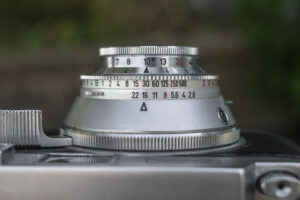
Looking down upon the top of the shutter, we see the typical controls found on most leaf shutter cameras. Closest to the body is the coupled shutter speed and aperture rings. The Adox 300 uses a coupled EV system which I am not a fan of. Turning these rings keeps the shutter speed and f/stops locked together so that the exposure value does not change. If you want to override the coupling and make independent changes of one or the other, a small button on the aperture ring, to the left of f/22 allows you to override it.
Nearest the front of the camera is the focus scale which has engravings from 3.5 feet to infinity. The marks for 7 and 20 are painted red to indicate group and landscape zone focus distances. That the Adox 300 was not sold in the US but has a scale in feet, not meters is certainly curious. I am unsure if other versions of this camera have a scale in meters.
In between the focus and exposure rings is a fixed depth of field scale on the front face of the Compur Rapid shutter. With the aperture at f/11 and the lens focused to 7 feet, everything from just under 5 feet to 13 feet will be in focus. With the camera still at f/11 but the lens focused to 13 feet, everything from 7 feet to infinity will be in focus. On the side nearest the 9 o’clock position of the shutter is a green lever for selecting X flash sync and self-timer (indicated by a V). Above this lever is a PC flash sync port.
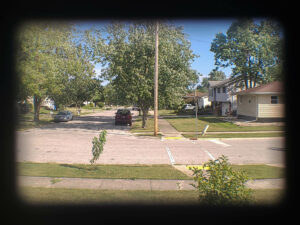
The designers who created the Adox 300 put a lot of thought into several aspects of the camera, however the viewfinder is not one of them. A simple optical viewfinder with a rectangular image and nothing else, no frame lines, no rangefinder, and nothing about exposure is seen. The mid 1950s are about the time when frame lines started to be more widely used in viewfinders, so it’s a bit disappointing to see such a basic viewfinder, but to be fair, in 1956 when this camera went on sale, most people likely weren’t expecting them. On the plus side though, I had no problem seeing all four edges of the viewfinder while wearing prescription glasses.
The Adox 300 was an ambitious camera created by a company with little experience making camera, centered around a feature that few people asked for, but despite this auspicious start, ended up with a pretty decent camera. The Adox 300 feels up to the challenge of daily use and has the build quality typical of mid 1950s German camera. It has a capable lens and shutter, an uncommon, but interesting film advance, and of course that magazine film back. Even if you never found a reason to hot swap rolls of film mid roll, the camera should be fun to use and capable of great images. But was it, and did it? Keep reading…
My Results
For the first roll of film through the Adox 300, I loaded up a roll of a film I had never used before, Kodak Supra 200. This medium speed color film from Kodak had an expiration date of 11/2005 and was marketed under the Kodak Professional brand, suggesting it might have been like a slightly faster version of Kodak Ektar 100. I had never shot the film before, so I gave it an extra stop of exposure and shot it like an ASA 100 speed film.
Having never shot an Adox 300 before nor Kodak Supra 200 film, in hindsight I probably should have only had one unknown variable, but as it would turn out, the inaugural roll was mostly a success. I say ‘mostly’ as the Kodak Supra 200 definitely showed some signs of age, as does most expired C41 color film. Mottled colors, a noticeable yellow shift, and extra grain added a distinct distressed look. The colors are somewhat muted, but in a pleasing way. I’ve found many other expired C41 films often show a strong magenta or cyan shift, which this didn’t have. The worst part of shooting this film however, was that it curled, BADLY. Scanning this on my Epson flatbed scanner was definitely a challenge.
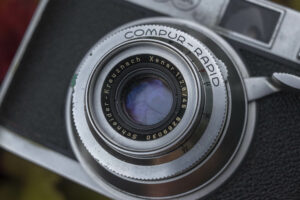
As for the camera itself, the images look great. Whether I was using expired or fresh color, I can already see that the four element Schneider Xenar delivered excellent results at least on par with most Tessar lenses. Sharpness was even across the frame with only minor softening and no vignetting in the corners.
While shooting the 300, I had no problem getting an entire roll of in focus photos. I’ve found that cameras like the Kodak Retina Ib, Apparate & Kamerabau Akarette, and Voigtländer Vito II to be faster to shoot without a rangefinder than with. That’s not to say that a rangefinder is always slower, but I find myself always wanting to use a rangefinder when one is available, even if I don’t need it. Take it away and you are free to zone focus and rely on depth of field.
The slightly wider 45mm Xenar lens has good depth of field and as long as I didn’t attempt any closeups with the lens wide open, I was able to get nearly every image sharply in focus. Using the depth of field calculator on the camera, with the lens focused to 7 feet and the diaphragm at f/8, everything from 5 feet to about 11 feet will be in focus, stop it down to f/16 and everything from 4 feet to just under 40 feet will be in focus. Set the focus ring to 20 feet, even at f/8 everything from about 9 feet to infinity is in focus making the camera sort of a group photo fixed focus camera.
The Adox 300 is now the fourth 35mm camera with a left thumb film advance lever. The other three being the Zeiss-Ikon Tenax II, Konica III, and Zenobia 35 F2, and I don’t know if I’m just getting used to this style of film advance, or if there is something different about this feature’s implementation in the Adox 300, but I enjoyed it more than I had with other cameras. The Adox uses a single stroke for advancing the film and cocking the shutter, unlike the Konica III which is a double stroke, and although the Zenobia 35 works pretty much the same way, that camera was stiffer than this Adox 300 which was very smooth and easy to actuate, making the whole process enjoyable.

The larger size and taller top plate makes for a heavy camera, but it improves the ergonomics a bit. I very much liked the location of the elongated oval shutter release as it fell exactly where my finger expected it to be. Looking at images of the Adox 500 prototype however, it would have been interesting to feel how a front body shutter release might have changed things, but as it is here, I found it to be very comfortable.
The viewfinder is simple and offers no frame lines or any sort of information about the status of the camera. That it lacks a rangefinder means that there is no beamsplitter partially deflecting some of the light which makes it very bright. Looking through the viewfinder on the Adox 300 is like looking through a window.
By far, the signature feature of the Adox 300 is it’s interchangeable magazine backs which gives you the flexibility to hot swap rolls of film in and out of the camera without ever having to rewind or finish the roll. On paper (or on screen) this likely sounds super cool, but in practice, it’s not the most intuitive process. I’ve handled the Kodak Ektra and a Mamiya Magazine 35 which has the same feature, and between those two cameras and this one, the process is unique for each model. Swapping magazines definitely requires you to read the manual as it’s not something the first time user will likely figure out themselves.
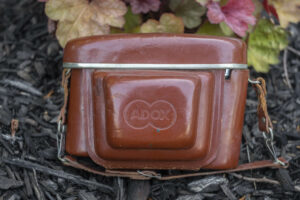
I have previously reviewed the Kodak Ektra and have personally handled a Mamiya Magazine which both support interchangeable film magazines, and in my opinion, Adox’s implementation is the best of the three. Swapping magazines in the Ektra is unnecessarily complicated and requires additional steps which are not obvious. Although Mamiya’s implementation is a little simpler than Kodak’s, the “magazine” is actually the entire body of the camera rather than something inside of the body that can be swapped out like the Adox. This makes the process clunky and unnecessarily exposes the shutter and lens of the camera to dust and damage while the magazine is removed. I don’t know how often anyone would want to hot swap rolls of 35mm film mid roll, but the lack of success for models like this suggests not many.
Overall, the Adox 300 is a terrific camera with a good lens and shutter, good ergonomics, excellent build quality, and the best implementation of a feature that few cameras ever had. Had the Adox 500 been officially released, with it’s coupled rangefinder and interchangeable lenses, it would have made for an extremely capable and fully featured camera. Sadly, it was not to be, but at the very least, we get a very cool camera that makes great pictures, and is definitely worthy of being added to your collection!
Related Posts You Might Enjoy
External Links
http://camera-wiki.org/wiki/Adox_300
https://www.shutterbug.com/content/adox-300-35mm-interchangeable-film-magazines
https://sites.google.com/site/harrissonphotographica/home/the-adox-300
http://www.cjs-classic-cameras.co.uk/other/non-folding.html#adox300

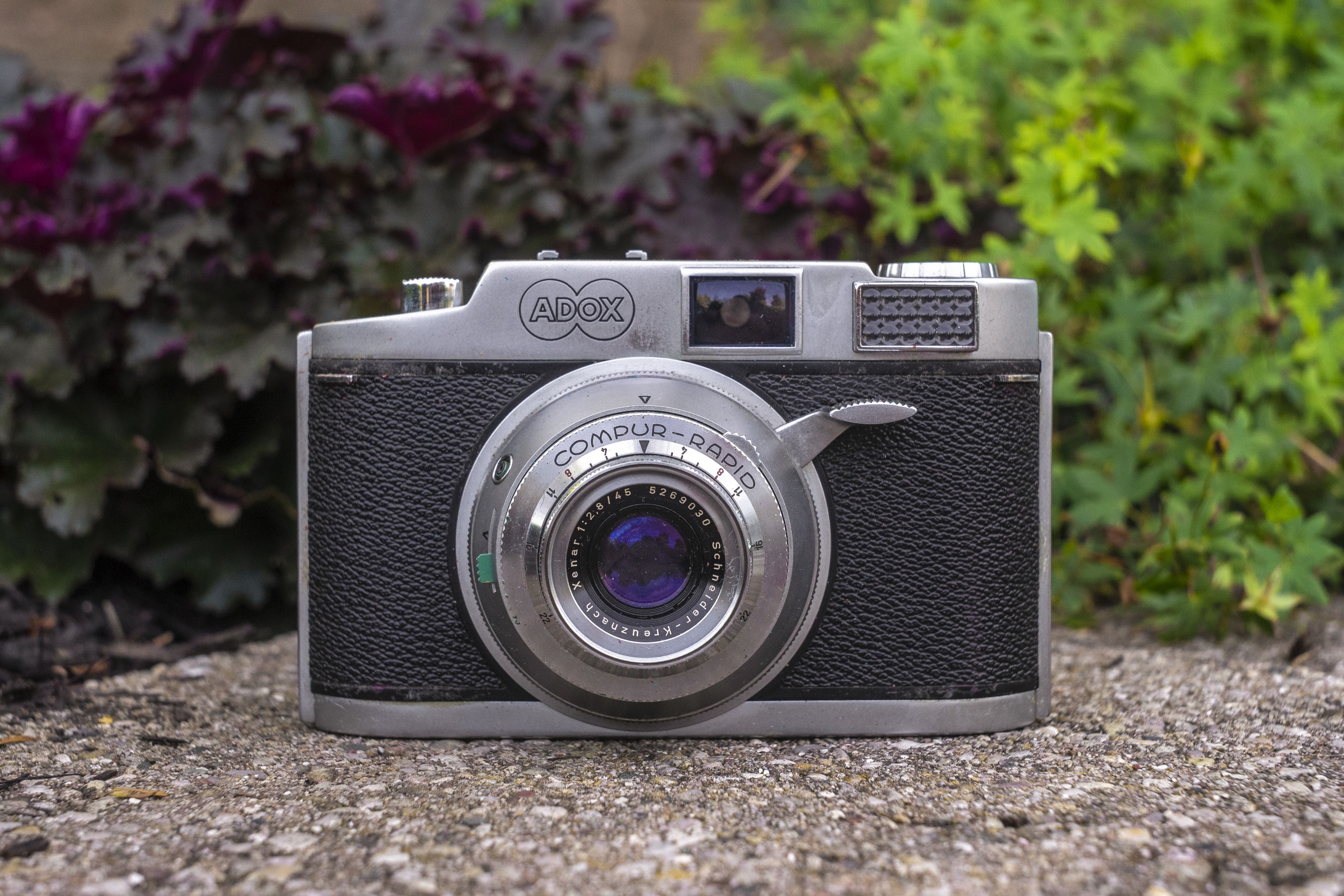
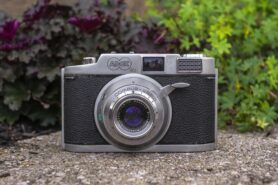
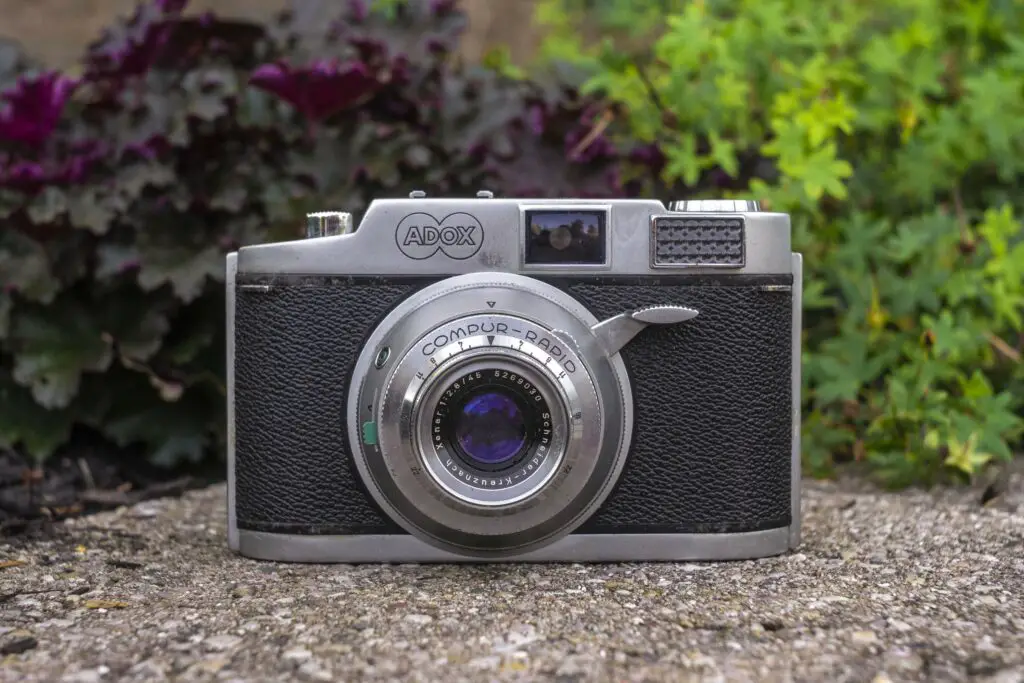
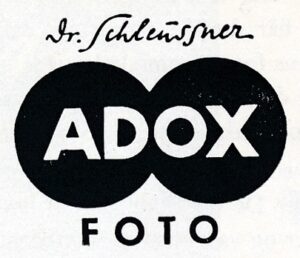
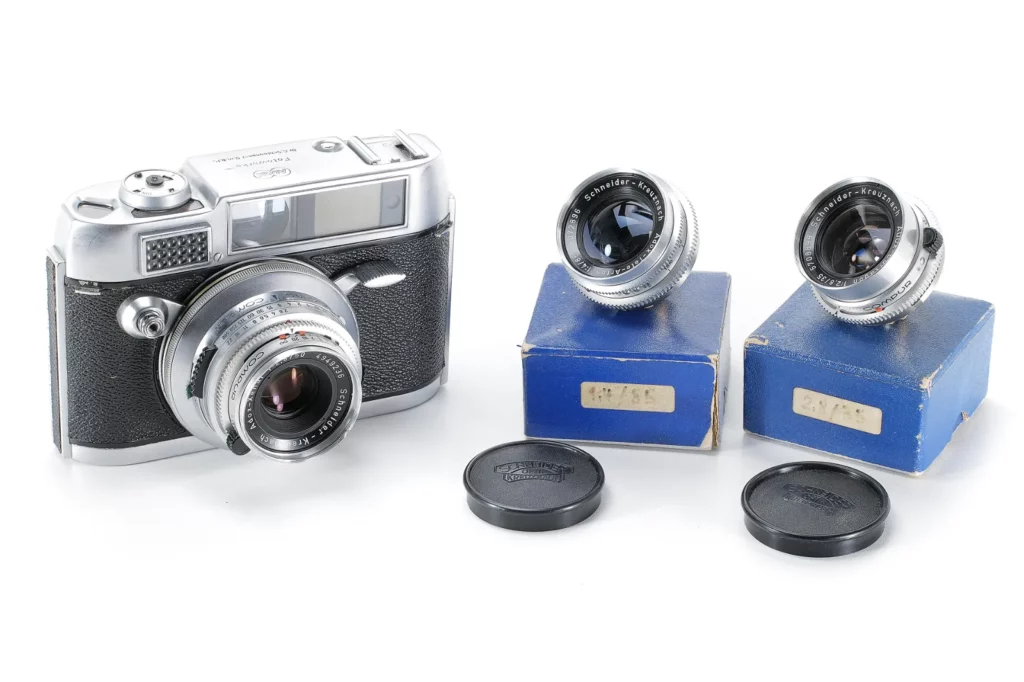

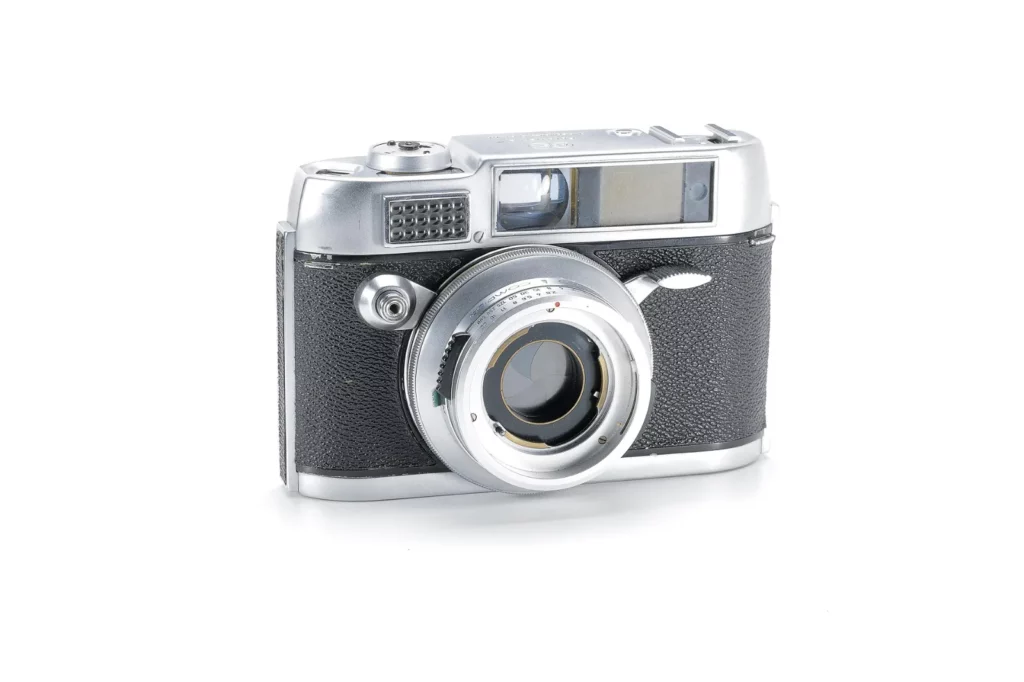

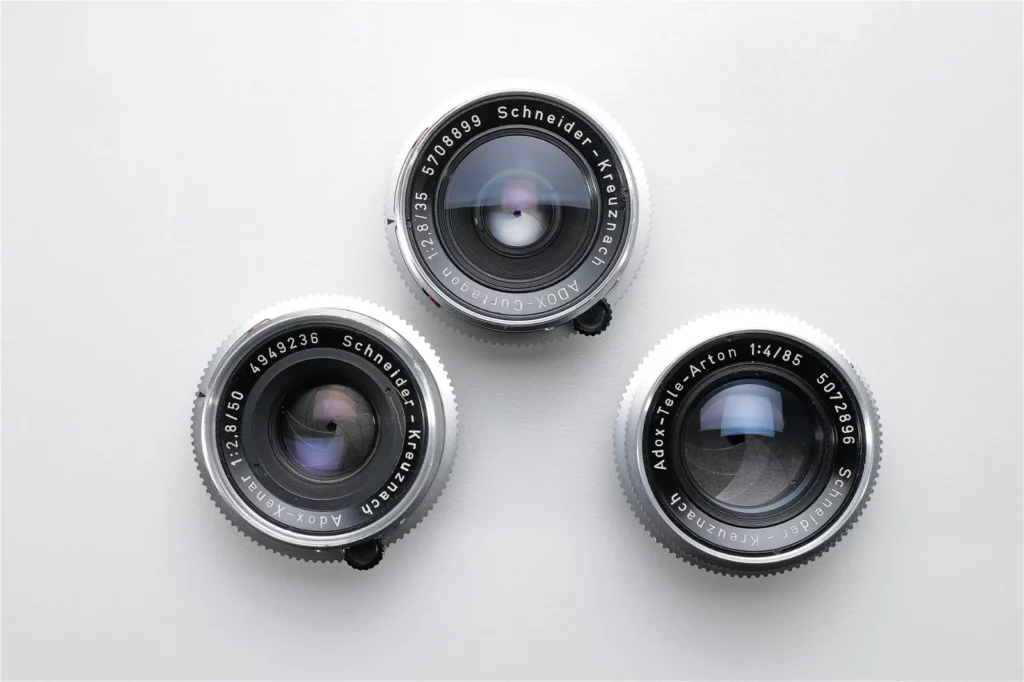
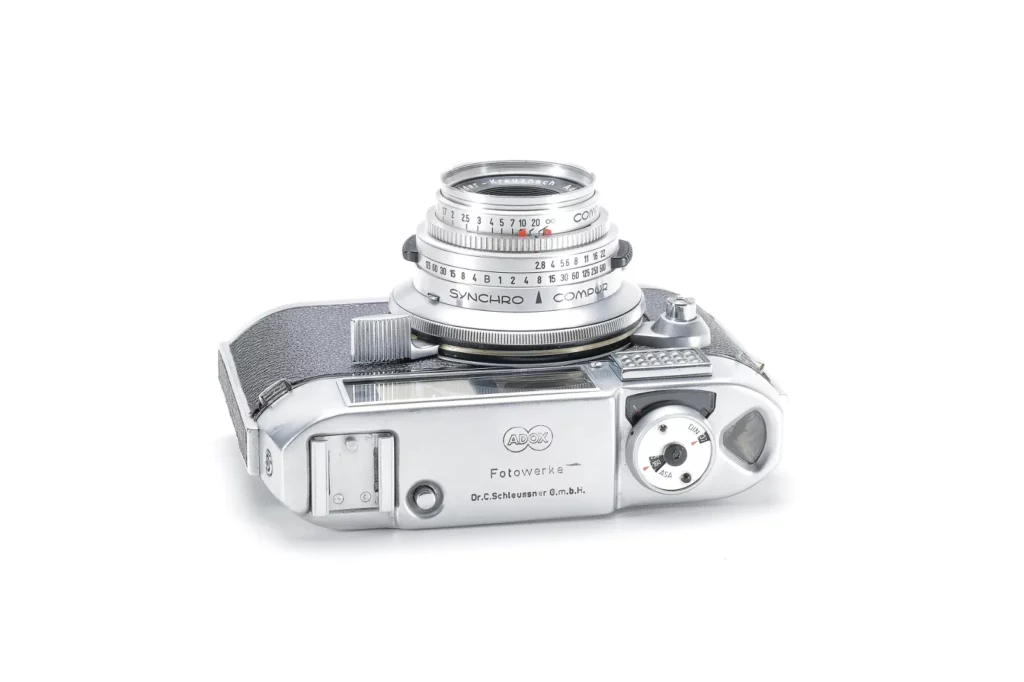

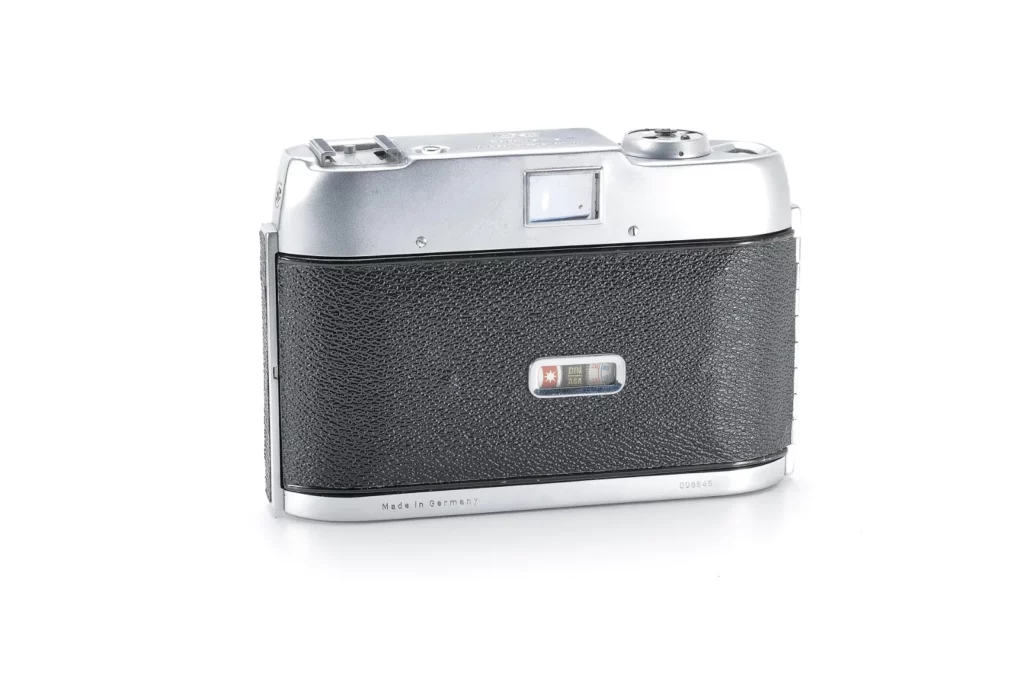
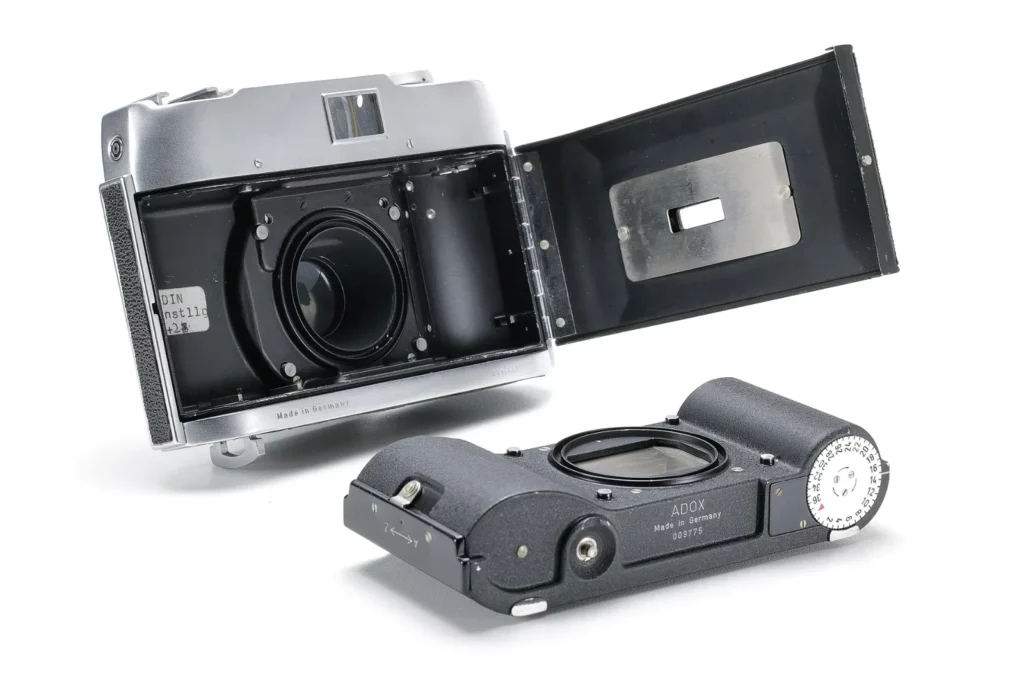
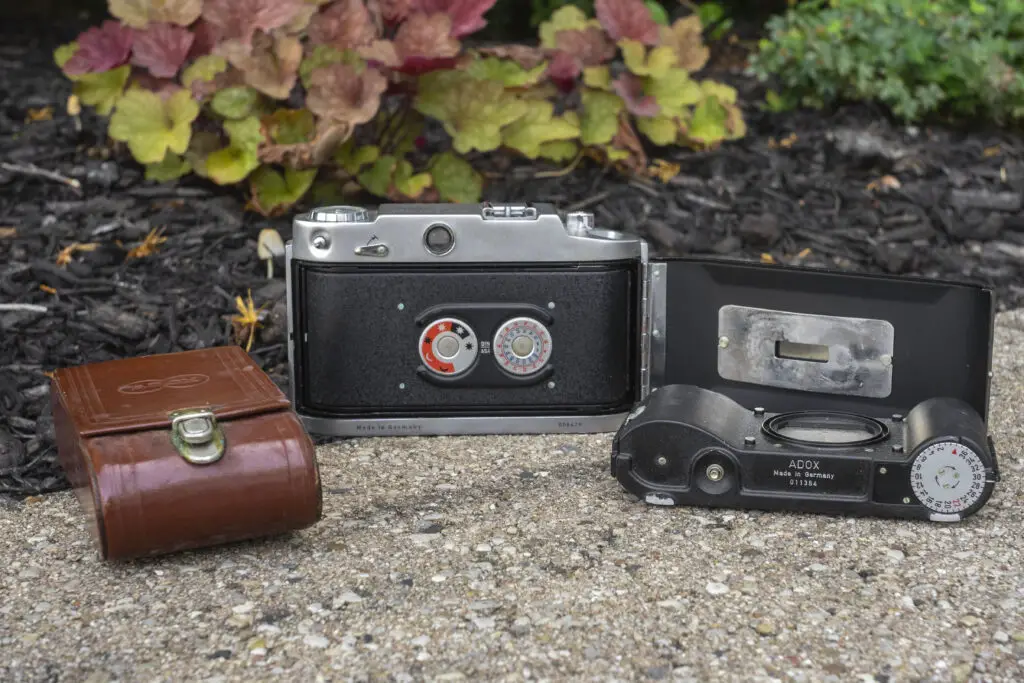
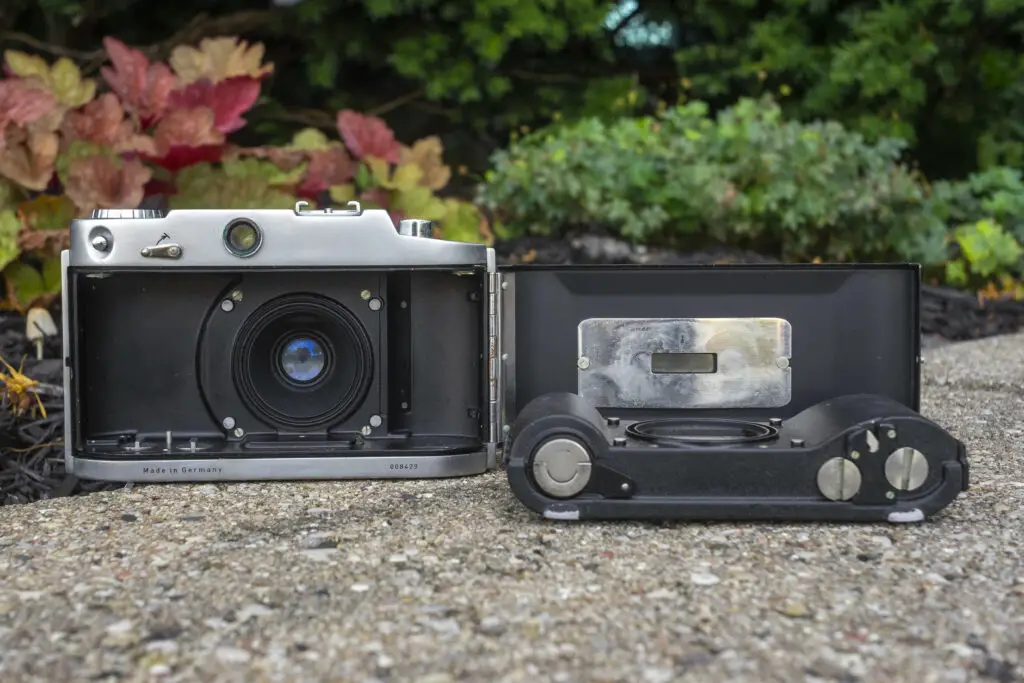
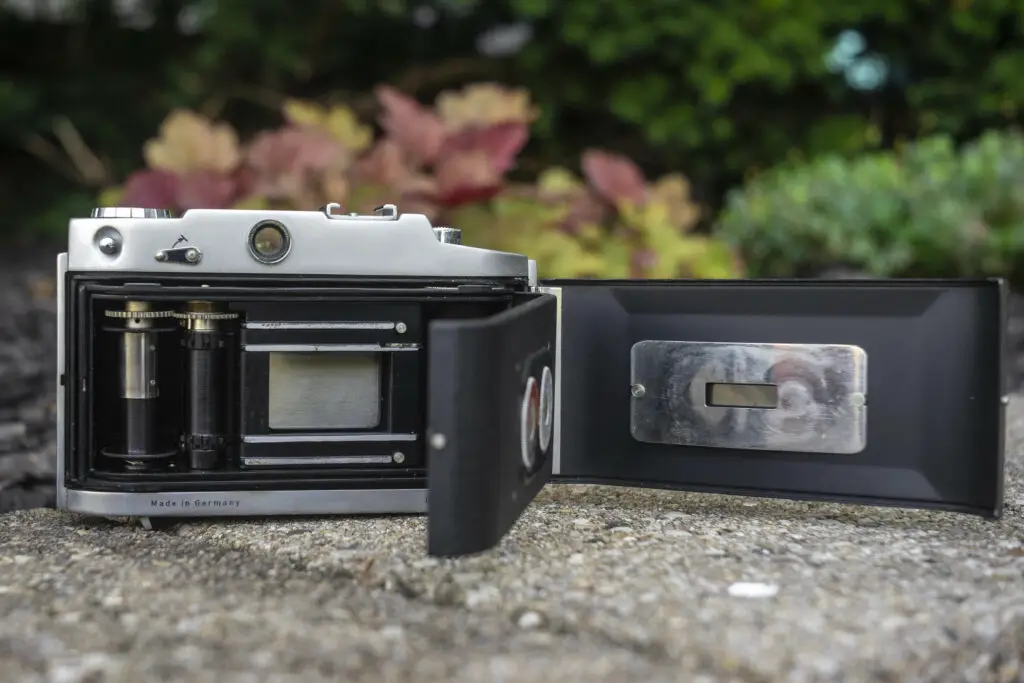
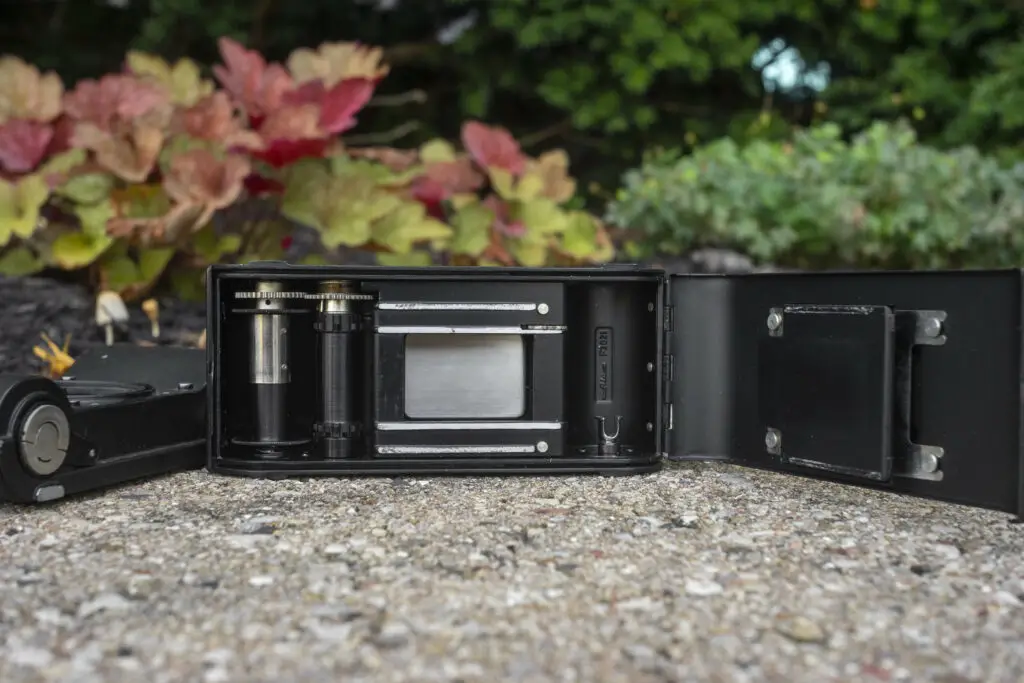

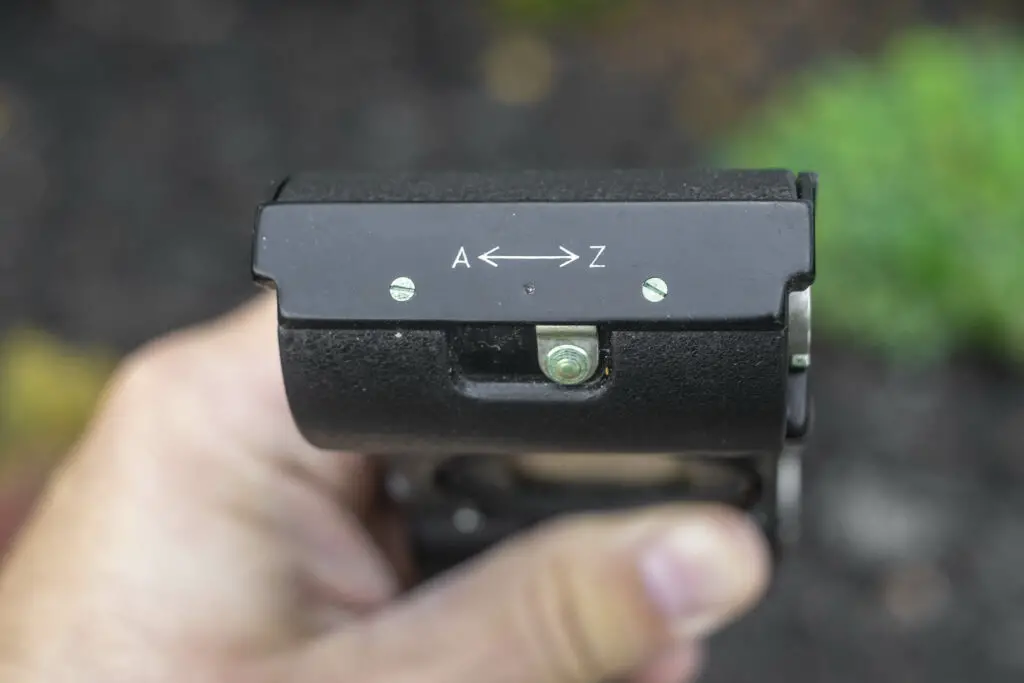





















The two old adds in this article, is both from a Danish, now closed company, called Belgium import Co.
The caption to one of the adds say it is a Norwegian ad, showing a price of 650 Kr.
That is not the case. I think it is a case of a missing picture.
Whoopsie! Apparently I need to re-take high school geography! I have fixed the error and updated the post. Thanks for the correction!
Very interesting camera, very detailed write-up. Adox also made a line of quality 120 folders, the “Golf” models. The “Mess-Golf” offered a built-in uncoupled rangefinder; the regular “Golfs” were scale focus. Based on the samples I’ve handled, the build and optical quality of these is on par with folders from Franka, as well as some Zeiss models.
Thank you for another great review of an interresting camera.
You are right, of course, that interchangeable magazines are not common on 35mm cameras, but it seems to me that you have overlooked what is probably the most common camera with this feature – the Zeiss Ikon Contaflex SLR. I don’t think the possibility of using intercangeable magazines is obvious when you first handle a Contaflex as it is just an option. In it’s basic form the camera handles like any other SLR (with respect to film loading, that is), but if you remove the camera back, the take-up spool and a piece of plastic from the film compartement, the camera is ready for the magazines. I was given a contaflex Super a couple of years ago with two magazines and I can report that the system certainly works very well. But the loading of the magazines is a bit more complicated than the Adox system seems to be and there is a loose cassette lid. There is a holder for the lid on the back of the magazine. I’m not sure if the magazine system was available for the first Contaflex models but at least it was from the Contaflex Super model. I don’t know how popular the system was as the camera worked just as well with the ordinary back. But I certainly would have liked to have axess to the system when I was young and ambituous and constantly found it difficult to choose between colour slides and black and white film.
I find it rather strange that Adox introduced their magazine system with such a basic camera. I would think that only professionals and advanced amateurs wanted it and then the rest of the camera didn’t meet their expectations.
I found an inflation calculator online and can report that the price of 650 dkr in 1956 equals about 1350 $ in 2020.
One more thing: I suppose the distance scale marked in feet indicates a model destined for the british market.
Kind regards
Andreas Berg
Andreas, thanks for the great message, and you’re right! I did completely omit the Contaflex from the list of magazine back 35mm cameras! I think the reason I forgot to include that as I was thinking of cameras who only support that feature and the Contaflex, as you mentioned, is an optional back. I actually believe that magazine back also works on the Icarex, but I’ve never tried it myself. Regarding introducing this feature on a basic camera, I really do believe the plan was to release the Adox 500 pretty after the 300 which would have been a much higher spec model, but of course, it never happened.
Thanks’ for your nice words. I agree with your thoughts about the Adox 500 being crucial in Adox’s plans – and also that the upcoming SLR changed everything. Regarding the Icarex I own both a Contaflex Super and both versions of the Icarex – that is both the fixed viewfinder version and the one with interchangeable finder. The Icarex does not take the Contaflex magazines. It doesn’t even have an interchangeable back. I remember that when I bought my first Icarex in 1971 or 72 I was attracted by the interchangeable magazine feature of the Contaflex but I went for the focal plane shutter of the Icarex as a leaf shutter SLR was clearly a thing of the past. Ironically the Icarex shutter turned out to be unreliable. I should have chosen the Nikkormat (same price) but was too heavily influenced by my father’s love for anything from Zeiss.